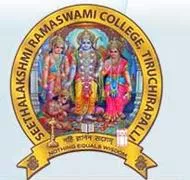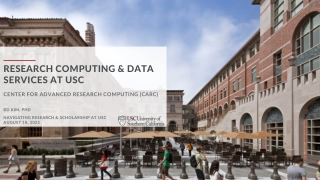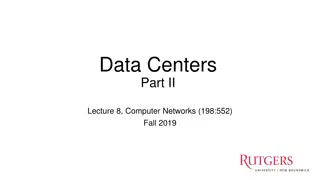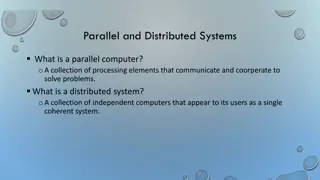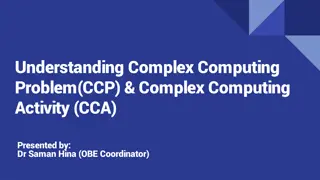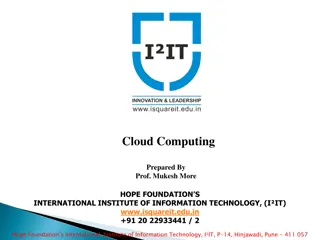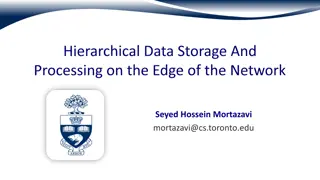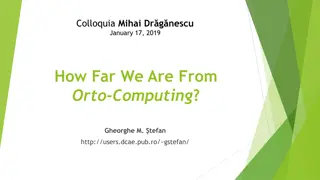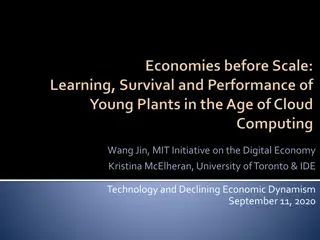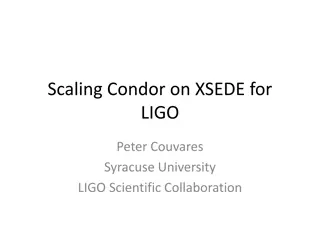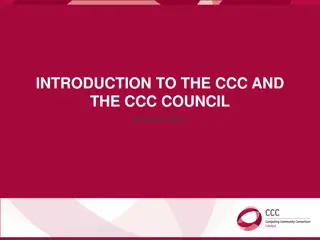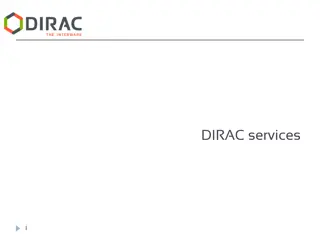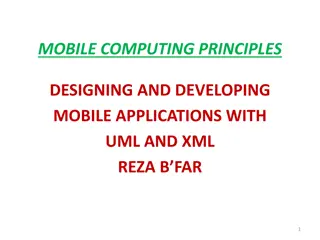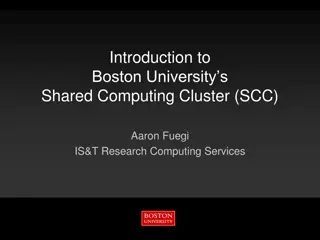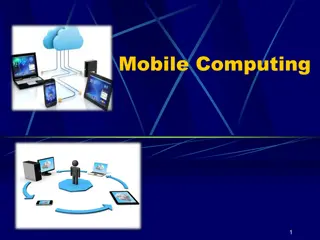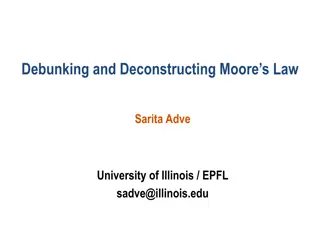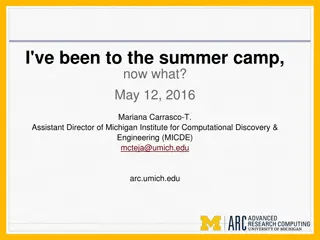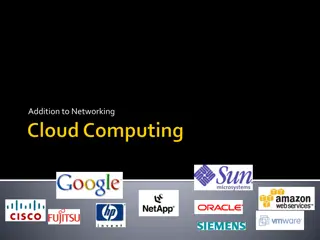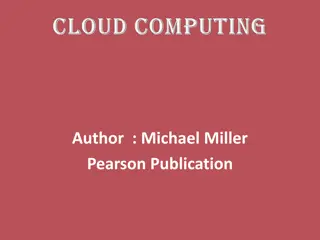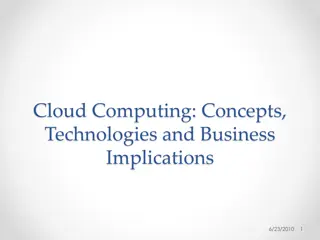Basic Concepts of Advanced Computing Techniques
Delve into the world of advanced computing techniques with Mrs. A. Mullai as she discusses networks, computing, and pervasive (ubiquitous) computing. Discover how networks facilitate data exchange, the role of computing in designing hardware and software systems, and the trend of embedding computational capabilities in everyday objects for seamless communication and task performance.
Download Presentation

Please find below an Image/Link to download the presentation.
The content on the website is provided AS IS for your information and personal use only. It may not be sold, licensed, or shared on other websites without obtaining consent from the author.If you encounter any issues during the download, it is possible that the publisher has removed the file from their server.
You are allowed to download the files provided on this website for personal or commercial use, subject to the condition that they are used lawfully. All files are the property of their respective owners.
The content on the website is provided AS IS for your information and personal use only. It may not be sold, licensed, or shared on other websites without obtaining consent from the author.
E N D
Presentation Transcript
Basic concepts of Advanced Computing Techniques - Mrs. A.Mullai 1 MY SRC MY PRIDE BASIC CONCEPTS OF ADVANCED COMPUTING TECHNIQUES Mrs. A. MULLAI ASSOCIATE PROFESSOR DEPARTMENT OF COMPUTER SCIENCE
NETWORKS 2 is a digital telecommunications network - allows nodes to share resources. In computer networks, exchange data with each other using a data link. The connections between nodes are established using either cable media or wireless media. Network computer devices that originate, route and terminate the data are called network nodes. Nodes can include hosts such as personal computers, phones, servers as well as networking hardware. Basic concepts of Advanced Computing Techniques - Mrs. A.Mullai
NETWORKS 3 support an enormous number of applications and Services - World Wide Web, digital video, digital audio, shared use of application and storage servers, printers, and fax machines, and use of email and instant messaging applications etc. differ in the transmission medium used to carry their signals, communications protocols to organize network traffic, the network's size, topology and organizational intent. The best-known computer network is the Internet. Basic concepts of Advanced Computing Techniques - Mrs. A.Mullai
COMPUTING 4 designing, developing and building hardware and software systems processing, structuring, and managing various kinds of information doing scientific research on and with computers making computer systems behave intelligently and creating and using communications and entertainment media Basic concepts of Advanced Computing Techniques - Mrs. A.Mullai
PERVASIVE (UBIQUTIOUS) COMPUTING 5 growing trend of embedding computational capability (generally in the form of microprocessors) everyday objects to make them effectively communicate and perform useful tasks minimizes the end user's need to interact with computers Pervasive computing devices are network-connected and constantly available. Basic concepts of Advanced Computing Techniques - Mrs. A.Mullai
PERVASIVE (UBIQUTIOUS) COMPUTING 6 Basic concepts of Advanced Computing Techniques - Mrs. A.Mullai
PERVASIVE (UBIQUTIOUS) COMPUTING 7 any device, at any time, in any place and in any data format across any network, and can hand tasks from one computer to another Example: laptops, notebooks and smartphones, but also tablets, wearable devices, lighting systems, appliances and sensors, and so on. The goal of pervasive computing is to make devices "smart, thus creating a sensor network capable of collecting, processing and sending data, and, ultimately, communicating as a means to adapt to the data's context and activity; in essence, a network that can understand its surroundings and improve the human experience and quality of life. Basic concepts of Advanced Computing Techniques - Mrs. A.Mullai
PERVASIVE (UBIQUTIOUS) COMPUTING 8 involve wireless communication and networking technologies, mobile devices, embedded systems, wearable computers, RFID tags, middleware and software agents. Internet capabilities, voice recognition and artificial intelligence Ex : keep tracking on the location of the people/object wearable devices Apple Watch informing a user of a phone call and allowing him to complete the call through the watch. Basic concepts of Advanced Computing Techniques - Mrs. A.Mullai
MOBILE (NOMADIC) COMPUTING 9 Users with portable computers Network connections Access anywhere, anytime, anyplace Normal fixed position to dynamic position Work process carried out - where it s n t previously possible Basic concepts of Advanced Computing Techniques - Mrs. A.Mullai
MOBILE COMMUNICATION 10 technology that allows transmission of data, voice and video via a computer or any other wireless enabled device without having to be connected to a fixed physical link. which involves Mobile communication Mobile hardware Mobile software Basic concepts of Advanced Computing Techniques - Mrs. A.Mullai
MOBILE COMPUTING 11 protocols, services, bandwidth, and portals The data format is also defined at this stage. there is no collision with other existing systems which offer the same service. radio wave-oriented. That is, the signals are carried over the air capable of receiving and sending similar kinds of signals. Basic concepts of Advanced Computing Techniques - Mrs. A.Mullai
MOBILE HARDWARE 12 receive or access the service of mobility. Ex: portable laptops, smartphones, tablet Pc's, Personal Digital Assistants. capable of sensing and receiving signals. operate in full- duplex - sending and receiving signals at the same time. They don't have to wait until one device has finished communicating for the other device to initiate communications. use an existing and established network to operate on. In most cases, it would be a wireless network. Basic concepts of Advanced Computing Techniques - Mrs. A.Mullai
MOBILE SOFTWARE 13 Mobile software is the actual program that runs on the mobile hardware. It deals with the characteristics and requirements of mobile applications. it is the operating system of the appliance. Basic concepts of Advanced Computing Techniques - Mrs. A.Mullai
CLOUD COMPUTING 14 umbrella - Internet based development and services Characteristics Remotely hosted: Services or data are hosted on remote infrastructure. Ubiquitous: Services or data are available from anywhere. Commodified: similar to traditional that of traditional utilities, like gas and electricity you pay for what you would want! Basic concepts of Advanced Computing Techniques - Mrs. A.Mullai
CLOUD COMPUTING 15 Basic concepts of Advanced Computing Techniques - Mrs. A.Mullai
CLOUD COMPUTING 16 Cloud Computing a new class of network based computing that takes place over the Internet, Utility Computing integrated and networked hardware, software and Internet infrastructure (called a platform). Using the Internet for communication and transport provides hardware, software and networking services to clients hide the complexity and details from users and applications simple graphical interface or API (Applications Programming Interface). Basic concepts of Advanced Computing Techniques - Mrs. A.Mullai
CLOUD COMPUTING 17 Shared pool of configurable computing resources APPLICATIONS (SERVICES) On-demand network access Provisioned by the Service Provider NETWORKS STORAGE (DATABASES) SERVERS Basic concepts of Advanced Computing Techniques - Mrs. A.Mullai
OPPORTUNITIES AND CHALLENGES 18 The use of the cloud provides a number of opportunities: It enables services to be used without any understanding of their infrastructure. Cloud computing works using economies of scale: no longer need to buy their own software or servers. Cost would be by on-demand pricing. Vendors and Service providers claim costs by establishing an ongoing revenue stream. Data and services are stored remotely but accessible from anywhere . Basic concepts of Advanced Computing Techniques - Mrs. A.Mullai
ADVANTAGES OF CLOUD COMPUTING 19 Lower computer costs: You do not need a high-powered and high-priced computer to run cloud computing web-based applications. desktop PC does not need the processing power or hard disk space UNLIKE traditional desktop software. PC can be less expensive, with a smaller hard disk, less memory, more efficient processor... does not even need a CD or DVD drive, as no software programs have to be loaded and no document files need to be saved. Basic concepts of Advanced Computing Techniques - Mrs. A.Mullai
ADVANTAGES OF CLOUD COMPUTING 20 Improved performance: better performance - PC. Computers in a cloud computing system boot and run faster - because they have fewer programs and processes loaded into memory Reduced software costs: Instead of purchasing expensive software applications can get most of what you need for free most cloud computing applications today, such as the Google Docs suite. better than paying for similar commercial software which alone may be justification for switching to cloud applications. Basic concepts of Advanced Computing Techniques - Mrs. A.Mullai
ADVANTAGES OF CLOUD COMPUTING 21 Instant software updates: no longer faced obsolete software and high upgrade costs. application is web-based, updates happen automatically available the next time you log into the cloud. you get the latest version without needing to pay for or download an upgrade. Improved document format compatibility. machine being compatible with other users' applications or OS. no format incompatibilities - sharing documents and applications in the cloud. Basic concepts of Advanced Computing Techniques - Mrs. A.Mullai
ADVANTAGES OF CLOUD COMPUTING 22 Unlimited storage capacity: Cloud computing offers virtually limitless storage. Your computer's current 1 Tbyte hard drive is small compared to the hundreds of Pbytes available in the cloud. Increased data reliability: Unlike desktop computing, in which if a hard disk crashes and destroy all your valuable data, a computer crashing in the cloud should not affect the storage of your data. if your personal computer crashes, all your data is still out there in the cloud, still accessible In a world where few individual desktop PC users back up their data on a regular basis, cloud computing is a data-safe computing platform! Basic concepts of Advanced Computing Techniques - Mrs. A.Mullai
ADVANTAGES OF CLOUD COMPUTING 23 Universal document access: That is not a problem with cloud computing, because you do not take your documents with you. Instead, they stay in the cloud, and you can access them whenever you have a computer and an Internet connection Documents are instantly available from wherever you are Latest version availability: When you edit a document at home, that edited version is what you see when you access the document at work. The cloud always hosts the latest version of your documents as long as you are connected, you are not in danger of having an outdated version Basic concepts of Advanced Computing Techniques - Mrs. A.Mullai
ADVANTAGES OF CLOUD COMPUTING 24 Easier group collaboration: Sharing documents leads directly to better collaboration. Many users do this as it is an important advantages of cloud computing multiple users can collaborate easily on documents and projects Device independence. no longer tethered to a single computer or network. Changes to computers, applications and documents - through the cloud. Move to a portable device - applications and documents are still available. Basic concepts of Advanced Computing Techniques - Mrs. A.Mullai
BIG DATA 25 Lots of data is being collected and warehoused Web data, e-commerce purchases at department/ grocery stores Bank/Credit Card transactions Social Network Basic concepts of Advanced Computing Techniques - Mrs. A.Mullai
BIG DATA 26 Collection of data sets so large and complex becomes difficult to process - database management tools or traditional data processing applications Big Data - scale, diversity, and complexity requires new architecture, techniques, algorithms, and analytics to manage it and extract value and hidden knowledge from it. Basic concepts of Advanced Computing Techniques - Mrs. A.Mullai
BIG DATA 27 big data - predictive analytics to extract value from information and rarely refers to size of the information set. may lead to the confident and better decision making - in developing greater operational efficiency, reduction in the cost and the risk. larger than the commonly used software tools to capture, curate and manage and process information within a defined time. The size is continuously increasing - from few terabytes to petabytes. characterized by high volume, velocity, and variety to need specifically applied science and analytical ways for its change into value. Basic concepts of Advanced Computing Techniques - Mrs. A.Mullai
BIG DATA 28 The big data has many characteristic and they are as follows: Volume Variety Velocity Variability Veracity Complexity Basic concepts of Advanced Computing Techniques - Mrs. A.Mullai
BIG DATA 29 Volume: it is the size of the data that explains the value and information & whether it can be viewed as a big data or not. Variety: it determines the class the big data belongs to it is also an essential factor that the data analyst should know. Velocity: refers to the speed of production of the information. Basic concepts of Advanced Computing Techniques - Mrs. A.Mullai
BIG DATA 30 Variability: it causes an issue to the people who analyze the information. Veracity: The quality of the information may vary a lot precision of analysis depends on the veracity factor of the source information. Complexity: The management of the data can become a difficult process - huge information comes from different sources. All these information needs to linked, correlate and connects with each other to acquire the data that is supposed to be transferred by this information. Basic concepts of Advanced Computing Techniques - Mrs. A.Mullai
BIG DATA 31 Generally, the factory work and the cyber-physical systems have a 6C system and this is as below: Connection Cloud Cyber Content Community Customization Basic concepts of Advanced Computing Techniques - Mrs. A.Mullai
STRUCTURE OF BIG DATA 32 The structure of the big data can be explained by the following: Structured Semi-structured Unstructured Structured: includes the traditional sources of information. Semi-structured: includes many sources of the big data. Unstructured: includes the information like video data and audio data. Basic concepts of Advanced Computing Techniques - Mrs. A.Mullai
ADVANTAGES OF THE BIG DATA 33 The advantages of the big data are as below: The big data is already a vital part of the $64 billion databases and the data analytics market. It furnishes commercial opportunities of a comparable. Basic concepts of Advanced Computing Techniques - Mrs. A.Mullai
APPLICATIONS OF BIG DATA 34 The applications of the big data are in the following fields: Government International development Manufacturing Cyber-physical models Media Technology Private sector Science Science and research Basic concepts of Advanced Computing Techniques - Mrs. A.Mullai
APPLICATIONS OF BIG DATA 35 Government: Ex: In USA the year 2012, Obama declared the big data research and development initiative - it is used to address many issues faced and also utilized by the Indian government. International development: cost-effective opportunities to enhance the decision in critical advancement areas like health care, employment opportunities and crime, security and natural disaster. Manufacturing: In manufacturing, the big data furnishes an infrastructure for transparency in manufacturing or producing industry. Basic concepts of Advanced Computing Techniques - Mrs. A.Mullai
...APPLICATIONS OF BIG DATA 36 Cyber-physical models: The present PHM implementations make avail of data during the actual usage analytical step by step procedures can do more precisely - when more data is included. Media: I it is used in the internet of things - the activities like targeting of computers and data capturing. Technology: In the technology, it is used in the websites like eBay, Amazon and Facebook and Google utilize it. Basic concepts of Advanced Computing Techniques - Mrs. A.Mullai
...APPLICATIONS OF BIG DATA 37 Private sector: includes the retail, retail banking, and real estate. Science: The best example for its application in science is about the Large Hardom collider that represented 150 million sensors transmitting information 40 million times per second. The big data also has the application in the science and research. The big data will be very advanced in the future as $15 billion is invested in software firms that are specialized in the data management and the data analytics. Basic concepts of Advanced Computing Techniques - Mrs. A.Mullai
REFERENCES 38 Principles Of Mobile Computing, Uwe Hansmann, Lothar Merk Martin S. Nicklous , Thomas Stober, Springer International Second Edition. Pervasive Computing Technology and Architecture of Mobile Internet Applications, Jochen Burkhardt, Dr. Horst Henn, Stefan Hepper,Klaus Rintdorff, Thomas Schack, Pearson Edition Cloud Computing, Dr. Kumar Saurabh, Wiley India Publication. Grid Computing, Joshy Joseph, Craig Fellenstein, Pearson Edition. Internet of Things From Research and Innovation to Market Deployment, Ovidiu Vermesan, Peter Friess, River Publishers, 2014. Basic concepts of Advanced Computing Techniques - Mrs. A.Mullai
REFERENCES 39 https://en.wikipedia.org/wiki/Mobile_computing https://www.techopedia.com/definition/2/cloud-computing https://www.techopedia.com/definition/28247/internet-of-things- iot https://www.oracle.com/in/big-data/guide/what-is-big-data.html https://www.techopedia.com/definition/28247/internet-of-things- iot https://www.oracle.com/in/big-data/guide/what-is-big-data.html Basic concepts of Advanced Computing Techniques - Mrs. A.Mullai
MY SRC MY PRIDE 40 THANK YOU ! Basic concepts of Advanced Computing Techniques - Mrs. A.Mullai

 undefined
undefined







